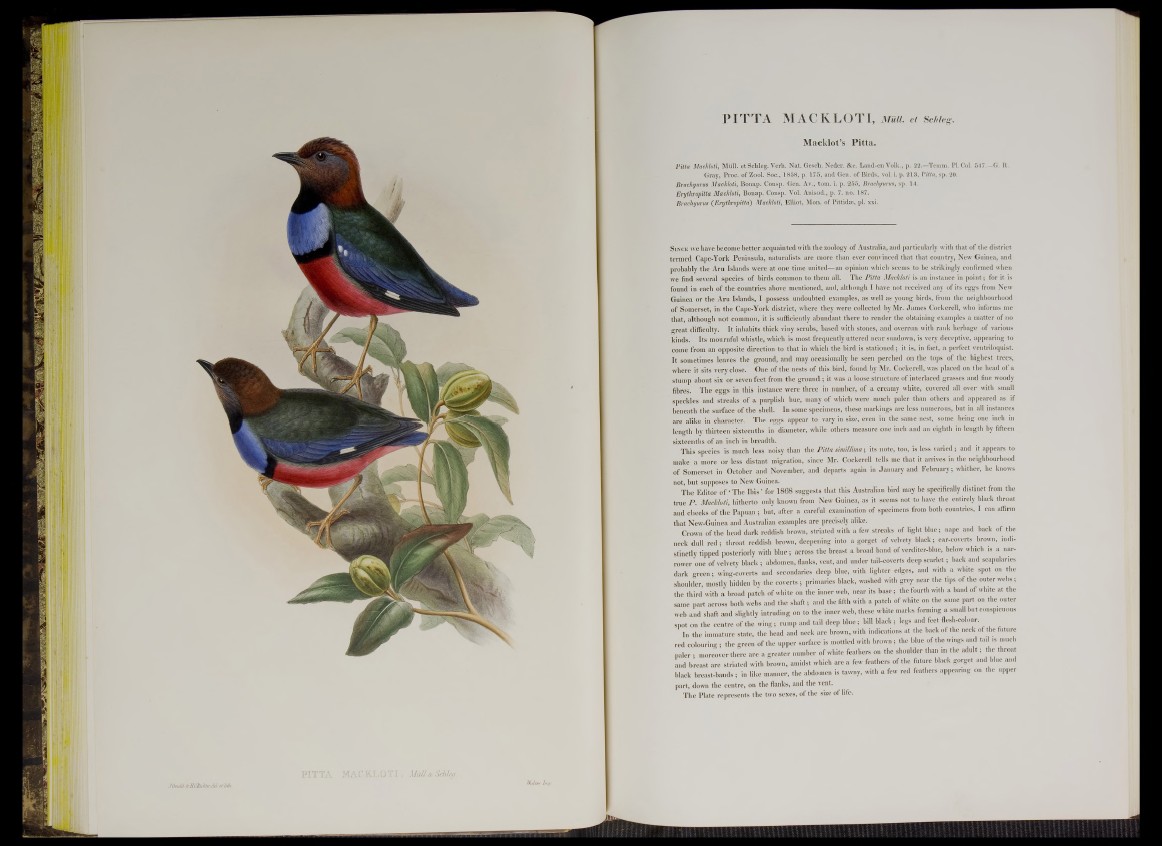
J.&oultL teUGBichter, dêb eb liOu.
PITTA MACK LOTI, m m . et Sc/iieg.
Macklot’s Pitta.
Pitta Mackloti, Mull. etSchleg. Verb. Nat. Gesch. Neder. &e. Land-en Volk., p. 22.—Temm. PI. Col. 547—G. R.
Gray, Proc, óf Zpol. Soc., 1858, p. 175, and Gen. of Birds, vol. i. p. 213, Pitta, sp. 20.
Brachyurus Mackloti, Bonap. Consp. Gen. Ay., tom. i. p. 255, Brachyurus, sp. 14.
Brythropitta Mackloti, Bonap. Consp. Vol. Anisod., p. 7. no. 187.
Brachyurus ('Erythropitta) Mackloti, Elliot, Mon. of Pittidm, pi. xxi.
S in c e we have become better acquainted with the zoology of Australia, and particularly with that of the district
termed Cape-York Peninsula, naturalists are more than ever convinced that that country, New Guinea, and
probably the Aru Islands were at one time united—an opinion whicli seems to be strikingly confirmed when
we find several species of birds common to them all. The Pitta Mackloti is an instance in point; for it is
found in each of the countries above mentioned, and, although I have not received any of its eggs from New
Guinea or the Aru Islands, I possess undoubted examples, as well as young birds, from the neighbourhood
of Somerset, in the Cape-York district, where they w'ere collected by Mr. James Cockerell, who informs me
that, although not common, it is sufficiently abundant there to render the obtaining examples a matter of no
great difficulty. It inhabits thick viny scrubs, based with stones, and overrun with rank herbage of various
kinds. Its mournful whistle, which is most frequently uttered near sundown, is very deceptive, appearing to
come from an opposite direction to that in which the bird is stationed; it is, in fact, a perfect ventriloquist.
It sometimes leaves the gronnd, and may occasionally be seen perched on the tops of the highest trees,
where it sits very close. One of the nests of this bird, found by Mr. Cockerell, was placed on the head of a
stump about six or seven feet from the ground ; it was a loose structure of interlaced grasses and fine woody
fibres. Thé eggs in this instance were three in number, of a creamy white, covered all over with small
speckles and streaks of a purplish hue, many of which were much paler than others and appeared as if
beneath the surface of the shell. In some specimens, these markings are less numerous, but in all instances
are alike in character. The eggs appear to vary in size, even in the same nest, some being one inch in
length by thirteen sixteenths in diameter, while others measure one inch and an eighth in length by fifteen
sixteenths of an inch in breadth.
This species is much less noisy than the Pitta simillima; its note, too, is less varied; and it appears to
make a more or less distant migration, since Mr. Cockerell tells me that it arrives in the neighbourhood
of Somerset in October and November, and departs again in January and February; whither, he knows
not, but supposes to New Guinea.
The Editor of ‘ The Ibis ’ for 1868 suggests that this Australian bird may be specifically distinct from the
true P . Mackloti, hitherto only known from New Guinea, as it seems not to have the entirely black throat
aud cheeks of the Papuan; but, after a careful examination of specimens from both countries, I can affirm
that New-Guinea and Australian examples are precisely alike.
Crown of the head dark reddish brown, striated with a few streaks of light blue; nape and back of the
neck dull red ; throat reddish brown, deepening into a gorget of velvety black; ear-coverts brown, indistinctly
tipped posteriorly with blue; across the breast a broad band of verditer-blue, below which is a narrower
one of velvety black ; abdomen, flanks, vent, and under tail-coverts deep scarlet; back and scapularies
dark green; wing-coverts and secondaries deep blue, with lighter edges, and with a white spot on the
shoulder, mostly hidden by the coverts ; primaries black, washed with grey near the tips of the outer webs;
the third with a broad patch of white on the inner web, near its base; the fourth with a band of white at the
same part across both webs and the shaft ; and the fifth with a patch of white on the same part on the outer
web and shaft and slightly intruding on to the inner web, these white marks forming a small but conspicuous
spot on the centre of the wing; rump and tail deep blue ; bill black ; legs and feet flesh-colour.
In the immature state, the head and neck are brown, with indications at the back of the neck of the future
red colouring ; the green of the upper surface is mottled with brown; the blue of the wings and tad ,s much
paler ■ moreover there are a greater number of white feathers on the shoulder than in the ad u lt; the throat
and breast are striated with brown, amidst which are a few feathers of the future black gorget and blue and
black breast-bands ; in like manner, the abdomen is tawny, with a few red feathers appearing on the upper
part, down the centre, on the flanks, and the vent.
The Plate represents the two sexes, of the size of life.